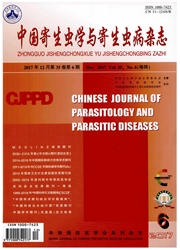

 中文摘要:
中文摘要:
目的 观察氯硝柳胺原位固化长效注射剂对感染日本血吸虫(Schistosoma japonicum)的小鼠和水牛的疗效。 方法 50只昆明小鼠随机均分为2组,给药组小鼠皮下注射低浓度氯硝柳胺原位固化长效注射剂(71 mg/ml)450 mg/kg 1次,对照组小鼠不作任何处理。给药后第1、15、43、57和71天,各组分别取5只小鼠采用腹部贴片法感染日本血吸虫尾蚴(80 ± 4)条/鼠。35 d后,处死小鼠,检获成虫,计算减虫率。10头水牛分成2组,给药组4头、对照组6头。给药组水牛皮下注射高浓度氯硝柳胺原位固化长效注射剂(222 mg/ml)30 mg/kg 1次,对照组水牛不作任何处理。于给药后第1和3个月粪检,计算粪检阳性率,并观察水牛的不良反应。采用SPSS19.0软件进行统计学分析,组间比较采用t检验。 结果 给药后第1、15、43、57和71天感染日本血吸虫尾蚴,35 d后给药组小鼠的虫荷分别为(3.6 ± 1.4)条、(17.5 ± 8.6)条、(10.0 ± 6.8)条、0 条、(11.3 ± 8.4)条,均少于对照组小鼠的虫荷(P 〈 0.05),且减虫率均超过50.0%。第1和3个月对水牛进行粪检,给药组均为阴性,对照组分别有2和3头阳性,其中1头牛给药后8 h出现精神沉郁。 结论 氯硝柳胺原位固化长效注射剂预防小鼠感染日本血吸虫尾蚴的作用达2个月,预防水牛感染日本血吸虫尾蚴的作用达3个月,具有现场应用预防血吸虫感染的潜力。
 英文摘要:
英文摘要:
Objective To observe the protective effect of niclosamide in situ sustained-release injection against Schistosoma japonicum infection in mice and buffaloes. Methods Fifty female mice were randomly divided into 2 groups. One group received a subcutaneous low-concentration niclosamide in situ sustained-release injection (71 mg/ml) at a single dose of 450 mg/kg (drug group, n = 25), while the other group did not receive any treatment (control group, n = 25). Each group was further divided into 5 subgroups, in which five mice were infected with 80 ± 4 Schistosoma japonicum cercariae on days 1, 15, 43, 57 and 71 after the treatment, and were sacrificed after 35 days to obtain adult worms and calculate the worm reduction rate. In the field trial, 10 buffaloes uninfected with Schistosoma japonicum were also divided into the drug group (n = 4) and the control group (n = 6). Buffaloes in the drug group were each given with a high concentration of niclosamide in situ sustained-release injection (222 mg/ml) at a single dose of 30 mg/kg, while those in the control did not receive any treatment. After 1 and 3 months, fecal examination was performed to detect Schistosoma japonicum infection in buffaloes. The positive rate was calculated and adverse reactions were observed. Between-group comparisons were made with t test by using the SPSS19.0 software. Results In mice infected with cercariae on days 1, 15, 43, 57 and 71 after drug treatment, the mean worm burden at 35 days after the infection was (3.6 ± 1.4), (17.5 ± 8.6), (10.0 ± 6.8), 0, and (11.3 ± 8.4) worms, respectively. All were significantly lower than that of the control(P 〈 0.05), and the worm reduction rates in drug group were all over 50.0%. Two and 3 infected buffaloes showed positive fecal examination at 1 and 3 months, respectively, while none in the drug group showed positive at both time points. One buffalo showed signs of depression at 8 h after treatment. Conclusion The niclosamide in situ sustained-release
 同期刊论文项目
同期刊论文项目
 同项目期刊论文
同项目期刊论文
 期刊信息
期刊信息
